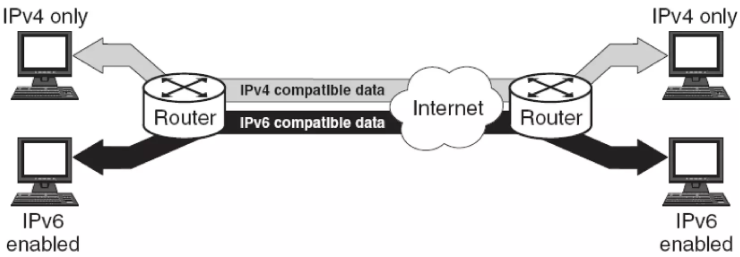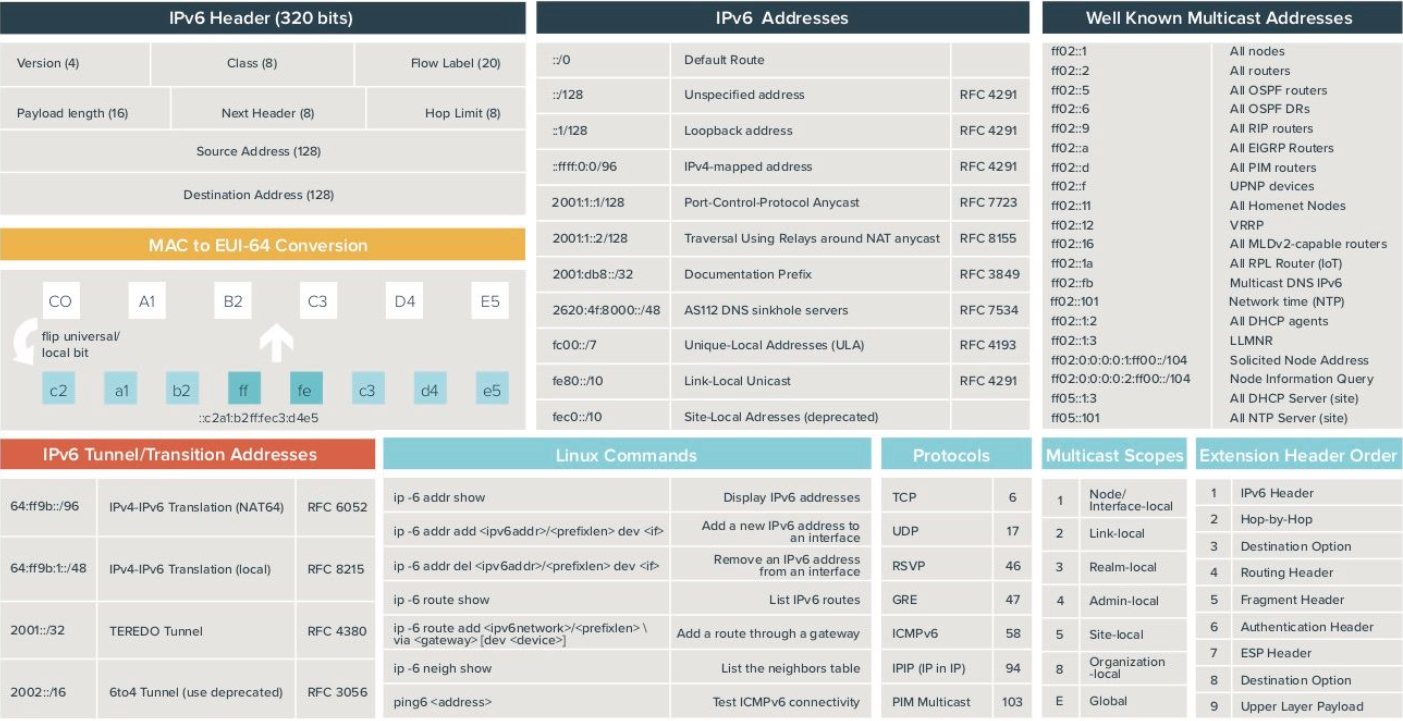Example: Calculating Subnets P2
- Determine the Subnet Ranges::
- Starting with 192.168.1.0, each subnet has 64 addresses, incrementing by 64 for each subsequent subnet.
| Subnet ID | Range | Description |
|---|---|---|
192.168.1.0/26 |
192.168.1.0 - 192.168.1.63 |
First subnet |
192.168.1.64/26 |
192.168.1.64 - 192.168.1.127 |
Second subnet |
192.168.1.128/26 |
192.168.1.128 - 192.168.1.191 |
Third subnet |
192.168.1.192/26 |
192.168.1.192 - 192.168.1.255 |
Fourth subnet |
Why IPv6?
IPv4 Address Exhaustion
-
IPv4: 32-bit address space (~4.3 billion addresses).
-
Increasing number of internet-connected devices.
-
IPv6: 128-bit address space
-
~340 undecillion addresses (enough for future needs).
Enhanced features:
-
Auto-configuration.
-
Improved security (IPSec).
-
Simplified header format.
IPv6 Address Format

-
Length: 128 bits (8 groups of 16 bits each).
-
Hexadecimal notation.
-
Groups separated by colons (e.g., 2001:0db8:85a3:0000:0000:8a2e:0370:7334).
Simplification Rules:
-
Remove leading zeros (e.g., 0010 -> 10).
-
Replace consecutive zero groups with :: (only once per address).
Anatomy of IPv6 address format: Example

IPv4 to IPv6 Transition
-
Dual Stack
-
Devices run both IPv4 and IPv6 simultaneously.
-
Allows gradual transition.
-

-
Tunneling
-
Encapsulates IPv6 packets within IPv4 headers.
-
Examples:
-
6to4: Automatically assigns an IPv6 prefix to IPv4.
-
Teredo: Tunnels IPv6 over IPv4 using NAT.
-
-

-
Translation
-
NAT64:
-
Maps IPv6 addresses to IPv4 and vice versa.
-
Enables IPv6-only devices to communicate with IPv4 devices.
-
-
IPv4 to IPv6
Step 1: Understand the IPv4 Address
- Example IPv4:
192.168.0.1 - Convert to binary:
- 192 ->
11000000 - 168 ->
10101000 - 0 ->
00000000 - 1 ->
00000001
- 192 ->
- Binary IPv4:
11000000.10101000.00000000.00000001
Step 2: Map IPv4 to IPv6 Format
- IPv6 has special prefixes for IPv4-mapped addresses:
::ffff:0:0/96
- Append the 32-bit binary IPv4 to the
::ffff:prefix.
Step 3: Convert Binary IPv4 to Hexadecimal
- IPv4 in binary:
11000000.10101000.00000000.00000001 - Group into 4-bit chunks:
1100 0000 1010 1000 0000 0000 0000 0001
- Convert each chunk to hexadecimal:
1100->C0000->01010->A1000->80000->00000->00000->00001->1
- Hexadecimal IPv4:
C0:A8:00:01
Step 4: Construct the IPv6 Address
- Prefix:
::ffff: - Hexadecimal IPv4:
C0:A8:00:01 - Combined:
::ffff:C0A8:01
Examples for Practice
Example 1
Convert the IPv4 address 10.0.0.1 to IPv6.
Solution
- Binary conversion:
- 10 ->
00001010, 0 ->00000000, 0 ->00000000, 1 ->00000001 - Binary:
00001010.00000000.00000000.00000001
- 10 ->
- Hexadecimal conversion:
0000 1010 0000 0000 0000 0000 0000 0001- Hexadecimal:
A:0:0:1
- IPv6 address:
::ffff:A:0:0:1
Example 2
Convert the IPv4 address 172.16.254.1 to IPv6.
Solution
- Binary conversion:
- 172 ->
10101100, 16 ->00010000, - 254 ->11111110, 1 ->00000001 - Binary:
10101100.00010000.11111110.00000001
- 172 ->
- Hexadecimal conversion:
1010 1100 0001 0000 1111 1110 0000 0001- Hexadecimal:
AC:10:FE:01
- IPv6 address:
::ffff:AC10:FE01
Cheat Sheet

Summary
- IPv4 is a 32-bit address space with classes for different network sizes.
- Subnetting divides a network into smaller parts using subnet masks.
- IPv6 due to exhaustion of IPv4 address spaces
- CIDR provides flexible subnetting options.
Internet Assigned Numbers Authority